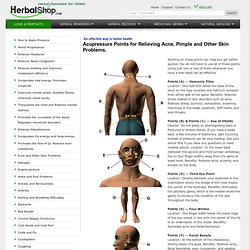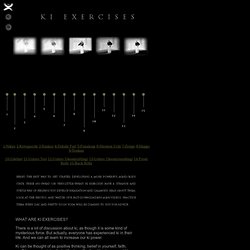

Acupressure Points for Relieving Acne, Pimple and Other Skin Problems. Working on these points can help you get better quicker.

You do not have to use all of these points. Using just one or two of them whenever you have a free hand can be effective. Points (A) -- Heavenly Pillar Location: One-half inch below the base of the skuIl on the ropy muscles one-half inch outward from either side of the spine. Benefits: Relieves stress related to skin disorders such as acne. Relieves stress, burnout, exhaustion, insomnia, heaviness in the head, eyestrain, stiff necks, and sore throats. Points (B) & Points (C) -- Sea of Vitality Caution: Do not press on disintegrating discs or fractured or broken bones.
Points (D) -- Third Eye Point Location: Directly between your eyebrows in the indentation where the bridge of the nose meets the center of the forehead. Points (E) -- Four Whites Location: One finger width below the lower ridge of the eye socket in line with the center of the iris in an indentation of the cheek. Learn Chinese Online - Content. Body Mind And Modem: Ki Exercises. There is a lot of discussion about ki, as though it is some kind of mysterious force.

But actually, everyone has experienced ki in their life. And we can all learn to increase our ki power. Ki can be thought of as positive thinking, belief in yourself, faith, confidence, or a state of mind/body unification. You have used ki quite naturally many times in your life, at those moments when something totally captured your interest and imagination. It may have been while you were playing a sport, working late into the morning on a project that was important to you, playing with your child, or simply spending time with someone you love.
In each case, you were totally focused and completely yourself. So that's what Ki exercises can do for you. Here is how we think you can use this Ki Exercise section best. Go through the exercises in order. Introduction to the I Ching. What the I Ching is and its use as an oracle.

The I Ching is a collection of practical wisdom, pertaining to every conceivable situation. It originates in ancient China and is the oldest Chinese classical text. "I Ching" means "Classic of Changes" or "Book of Changes. " (While mostly the spelling "I Ching" is used, "Yijing" is in fact the official modern spelling.) There are 64 different main kinds of situations in the I Ching. To obtain advice from the I Ching about one's current situation, one can consult it as an oracle. There doesn't seem to be any scientific theory that explains how this can be (although some people think quantum mechanics provides for a possible explanation). Hexagrams and lines Hexagrams are sets of six lines, that can be broken or unbroken . The 64 hexagrams are indicated by a number, that is universal. Consulting the I Ching Traditionally the I Ching is consulted by throwing 50 yarrow stalks, but usually a set of three coins is used.
No changing lines 1 changing line. Phorum - Chinese Medicine Forum at Asiawind. ChiMed Home Page.